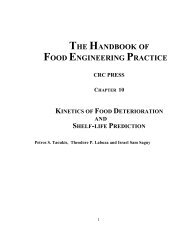Download
Download
Download
You also want an ePaper? Increase the reach of your titles
YUMPU automatically turns print PDFs into web optimized ePapers that Google loves.
Bovine GI tractpH (6.0-7.0)pH (2.0-3.0)
Bovine GI tract• The rumen has a pH of 5.5-7.0 depending on volatilefatty acid (VFA) production from feeds• The main VFA’s are propionic, acetic and butyric acids• These produce a mild acidic environment (pH 4.0-5.0)in the rumen• In the abomasum or stomach a harsh acidic environment(pH 2.0-3.0) is produced by HCL• Acid from the abomasum is neutralised in the smallintestines with an alkaline secretion (pH 7.0-8.0)
Pathogen survival in the GI tract• Domestic livestock are primary habitats forEscherichia, Salmonella, Shigella & Campylobacter• These organisms survive passage through theentire GI tract• In the rumen pathogens are exposed to a mild acidstress (pH 4.0-5.0) in the presence of VFA’s• In the abomasum cells are exposed to severe acidstress (pH 2.0-3.0) in the presence of HCL
Acid adaptation in propionic acid of S. Typhimurium atdifferent pHs & survival (%) after acid challenge at pH 3.010075% Survival502505 6 7 8pHKwon & Ricke, 1998
Survival in the abomasum• Cells entering the abomasum were acid resistant (AR)• E. coli O157:H7 survives acid challenge at pH 2.5• Feeding regime had a major effect on survival• At a lower pH survival is improved• Strain variation was shown to occur• These experiments were carried out in sterile fluids
Influence of feeding regimes on acidadaptation & resistance in E. coli O157:H7• Cattle fed grain had more acid resistant E. colithan animals fed hay (Diez-Gonzalez & Russell,1998)• Cattle fed grain or hay had equal numbers of acidresistant E. coli (Hovde et al., 1999)
Acid adaptation in the live animal• Acid adaptation has not been shown to beassociated with a particular system in the liveanimal• It is likely that acid adaptation results from anoverlapping between different systems
Acid adaptation and resistance infoods & humans• During food processing enteric pathogens maybecome acid adapted• This ensures survival in the human stomach• Stresses induced in foods are also found inhumans
Stresses which occur in foods & in humansFoods/process Stress Human bodyMayonnaise, fermented Acid Stomach/small intestinefoods pepperoni, salami colon/phagosomesCooking/processing Heat Temperature upshiftintracellularenvironmentFish, brines, marinades Osmolarity Stomach(salt solutions)Sous vide - VP Anaerobiosis Phagosomesof meatSheridan & McDowell, 1998
Survival on foods and in humans• Acid resistance develops throughout the animalintestinal tract in the rumen, abomasum & intestines• Acid resistant pathogens in faeces may contaminatecarcasses during slaughter• Resistance may persist in adapted cells during coldstorage for periods >70 days• Cells from animals or foods are acid adapted forpersistance in the human stomach
Leyer and Johnson, 1992The influence of acid adaption on survival ofSalmonella in cheese1000% Survival1001010.10.01AdaptedNon-adapted0.0010.00010 20 40 60 80Days
Pathogen survival & replicationin protozoa• The rumen has very large numbers of protozoa 10 -6 ml -1• Protozoa are present in large numbers in water & soil• Enteric pathogens may use protozoa as a means ofsurvival, replication & increasing virulence in theseenvironments
Pathogen replication in AcanthamoebaKuiper et al., 2004
Virulence enhancement in rumen protozoa% Hep-2 cell invasionSalmonella strainsRasmussen et al., 2005
Pathogen survival in protozoa• Enteric pathogens may survive & replicate inprotozoa, mainly Amoeba• Pathogens within protozoa may show enhancedvirulence• Increased virulence is related to the presence ofthe SGI1 resistance integron• This may be a significant pathogen survivalmechanism in water, the rumen & in soil
Alternative pathogen survival mechanisms- predator cytotoxicity• Gram negative organisms produce vesicles ontheir surfaces• Vesicles from E. coli O157:H7 contain shiga toxins• When engulfed by Acanthamoeba the toxin killsthe organism• A possible survival mechanism in soil?
E. coli O157:H7 producing vesicles containingshiga toxinsVesiclesKolling & Matthews, 1999
Conclusions• Research is required to determine how pathogens survivein complex communities such as the GI tract• Controlling acid adaptation of enteric pathogens in therumen would offer a unique opportunity for control sinceunadapted cells would not survive the pH of the abomasum• Control of enteric pathogens in the live animal willdepend on the development of methods & a detailedunderstanding of pathogen acid adaptation & resistance• The significance of pathogen survival, replication &virulence enhancement in protozoa requires furtherinvestigation














